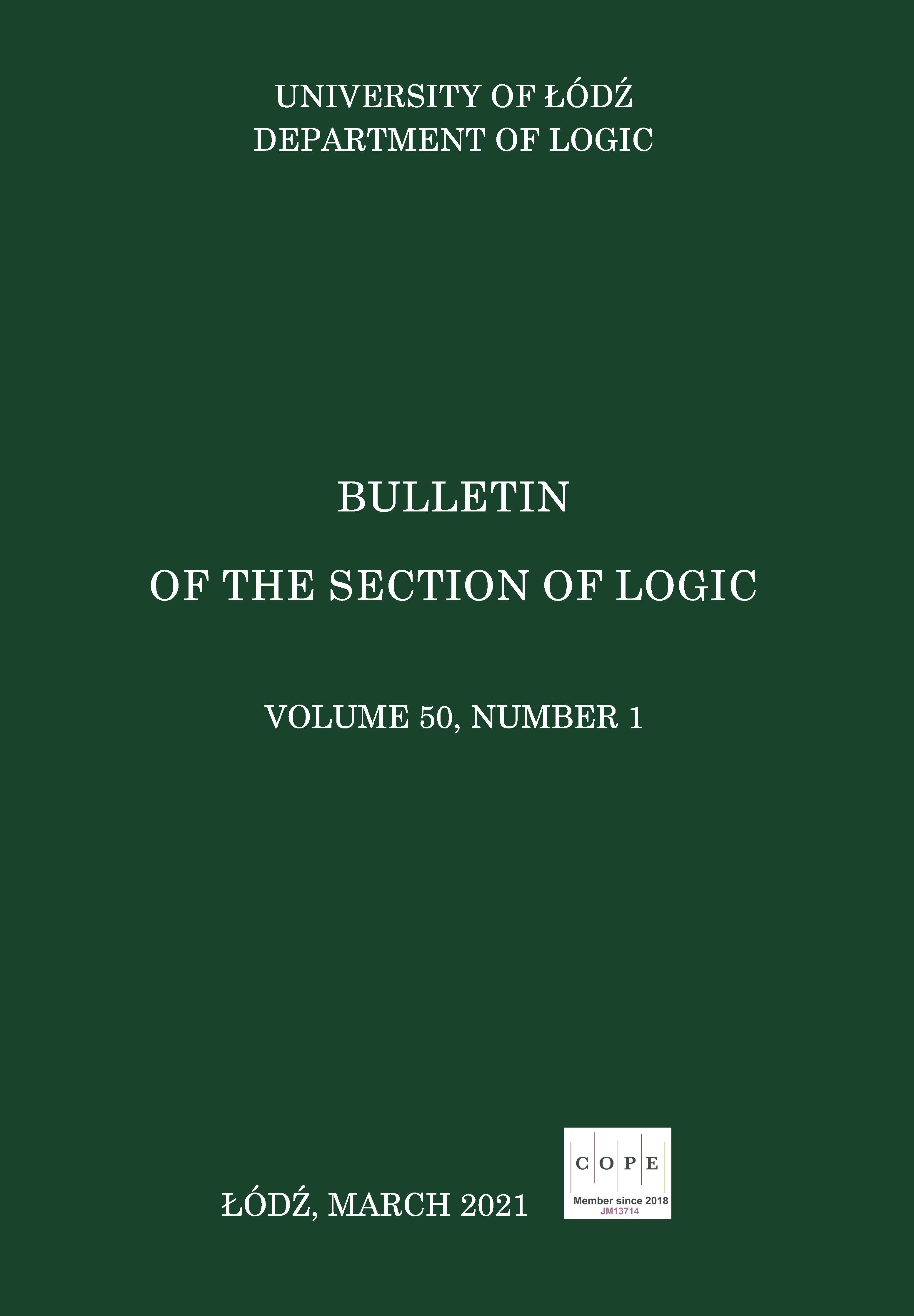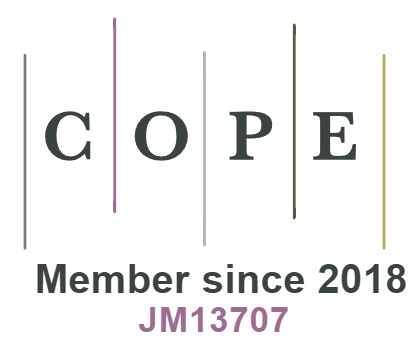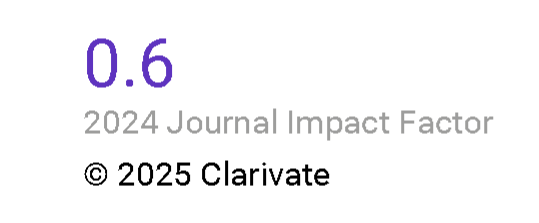A Semi-lattice of Four-valued Literal-paraconsistent-paracomplete Logics
DOI:
https://doi.org/10.18778/0138-0680.2020.24Keywords:
Four-valued logics, paraconsistent logics, paracomplete logics, isomorphisms, literal-paraconsistent-paracomplete logics, semi-lattice of logicsAbstract
In this paper, we consider the class of four-valued literal-paraconsistent-paracomplete logics constructed by combination of isomorphs of classical logic CPC. These logics form a 10-element upper semi-lattice with respect to the functional embeddinig one logic into another. The mechanism of variation of paraconsistency and paracompleteness properties in logics is demonstrated on the example of two four-element lattices included in the upper semi-lattice. Functional properties and sets of tautologies of corresponding literal-paraconsistent-paracomplete matrices are investigated. Among the considered matrices there are the matrix of Puga and da Costa's logic V and the matrix of paranormal logic P1I1, which is the part of a sequence of paranormal matrices proposed by V. Fernández.
References
[1] O. Arieli, A. Avron, Four-valued paradefinite logics, Studia Logica, vol. 105(6) (2017), pp. 1087–1122, DOI: https://doi.org/10.1007/s11225-017-9721-4
Google Scholar
DOI: https://doi.org/10.1007/s11225-017-9721-4
[2] D. A. Bochvar, V. K. Finn, On many-valued logics admitting formalization of the analysis of antinomies. 1, [in:] Studies in mathematical linguistics, mathematical logic and information languages, Nauka, Moscow (1972), pp. 238–295.
Google Scholar
[3] L. Bolc, P. Borowik, Many-valued Logics: 1: Theoretical Foundations , Springer-Verlag Berlin Heidelberg (1992).
Google Scholar
DOI: https://doi.org/10.1007/978-3-662-08494-6_1
[4] J. Ciuciura, A weakly-intuitionistic logic I1, Logical Investigations, vol. 21(2) (2015), pp. 53–60.
Google Scholar
DOI: https://doi.org/10.21146/2074-1472-2015-21-2-53-60
[5] L. Y. Devyatkin, On a continual class of four-valued maximally paranormal logics, Logical Investigations, vol. 24(2) (2018), pp. 85–91, DOI: https://doi.org/10.21146/2074-1472-2018-24-2-85-91 , in Russian.
Google Scholar
DOI: https://doi.org/10.21146/2074-1472-2018-24-2-85-91
[6] V. L. Fernández, Semântica de Sociedades para Lógicas n-valentes, Master's thesis, Campinas: IFCH-UNICAMP (2001).
Google Scholar
[7] V. L. Fernández, M. E. Coniglio, Combining valuations with society semantics, Journal of Applied Non-Classical Logics, vol. 13(1) (2003), pp. 21–46, DOI: https://doi.org/10.3166/jancl.13.21-46
Google Scholar
DOI: https://doi.org/10.3166/jancl.13.21-46
[8] S. Jaśkowski, A propositional calculus for inconsistent deductive systems, Studia Logica, vol. 24 (1969), pp. 143–157.
Google Scholar
DOI: https://doi.org/10.1007/BF02134311
[9] A. Karpenko, N. Tomova, Bochvar's three-valued logic and literal paralogics: the lattice and functional equivalence, Logic and Logical Philosophy, vol. 26(2) (2017), pp. 207–235, DOI: https://doi.org/10.12775/LLP.2016.029
Google Scholar
[10] A. S. Karpenko, Jaśkowski's criterion and three-valued paraconsistent logics, Logic and Logical Philosophy, vol. 7 (1999), pp. 81–86, DOI: https://doi.org/10.12775/LLP.1999.006
Google Scholar
DOI: https://doi.org/10.12775/LLP.1999.006
[11] A. S. Karpenko, A maximal paraconsistent logic: The combination of two three-valued isomorphs of classical propositional logic, [in:] D. Batens, C. Mortensen, G. Priest, J.-P. Van Bendegem (eds.), Frontiers of Paraconsistent Logic, Baldock Research Studies Press (2000), pp. 181–187.
Google Scholar
[12] A. S. Karpenko, N. E. Tomova, Bochvar's three-valued logic and literal paralogics, Institute of Philosophy of Russian Academy of Science, Moscow (2016).
Google Scholar
DOI: https://doi.org/10.12775/LLP.2016.029
[13] R. A. Lewin, I. F. Mikenberg, Literal-paraconsistent and literal-paracomplete matrices, Mathematical Logic Quarterly, vol. 52(5) (2006), pp. 478–493, DOI: https://doi.org/10.1002/malq.200510044
Google Scholar
DOI: https://doi.org/10.1002/malq.200510044
[14] E. Mendelson, Introduction to Mathematical Logic, 4th ed., Chapman & Hall (1997).
Google Scholar
[15] Y. I. Petrukhin, Deduction Normalization Theorem for Sette's Logic and Its Modifications, Moscow University Mathematics Bulletin, vol. 74(1) (2019), pp. 25–31, DOI: https://doi.org/10.3103/S0027132219010054
Google Scholar
DOI: https://doi.org/10.3103/S0027132219010054
[16] V. M. Popov, On the logics related to A. Arruda's system V1, Logic and Logical Philosophy, vol. 7 (1999), pp. 87–90, DOI: https://doi.org/10.12775/LLP.1999.007
Google Scholar
DOI: https://doi.org/10.12775/LLP.1999.007
[17] G. Priest, K. Tanaka, Z. Weber, Paraconsistent logic (2013), URL: http://plato.stanford.edu/entries/logic-paraconsistent , Stanford Encyclopedia of Philosophy.
Google Scholar
[18] L. Z. Puga, N. C. A. Da Costa, On the imaginary logic of N. A. Vasiliev, Zeitschrift für mathematische Logik und Grundlagen der Mathematik, vol. 34 (1988), pp. 205–211.
Google Scholar
DOI: https://doi.org/10.1002/malq.19880340304
[19] A. M. Sette, On propositional calculus P1, Mathematica Japonicae, vol. 18 (1973), pp. 173–180.
Google Scholar
[20] A. M. Sette, E. H. Alves, On the equivalence between some systems of non-classical logic, Bulletin of the Section of Logic, vol. 25(2) (1973), pp. 68–72.
Google Scholar
[21] A. M. Sette, W. A. Carnielli, Maximal weakly-intuitionistic logics, Studia Logica, vol. 55(1) (1995), pp. 181–203, DOI: https://doi.org/10.1007/BF01053037
Google Scholar
DOI: https://doi.org/10.1007/BF01053037
[22] N. E. Tomova, On properties of a class of four-valued papranormal logics, Logical Investigations, vol. 24(1) (2018), pp. 75–89, DOI: https://doi.org/10.21146/2074-1472-2018-24-1-75-89
Google Scholar
DOI: https://doi.org/10.21146/2074-1472-2018-24-1-75-89
[23] N. E. Tomova, A. N. Nepeivoda, Functional properties of four-valued paralogics, Logical-Philosophical Studies, vol. 16(1–2) (2018), pp. 130–132.
Google Scholar
Downloads
Published
How to Cite
Issue
Section
License

This work is licensed under a Creative Commons Attribution-NonCommercial-NoDerivatives 4.0 International License.















